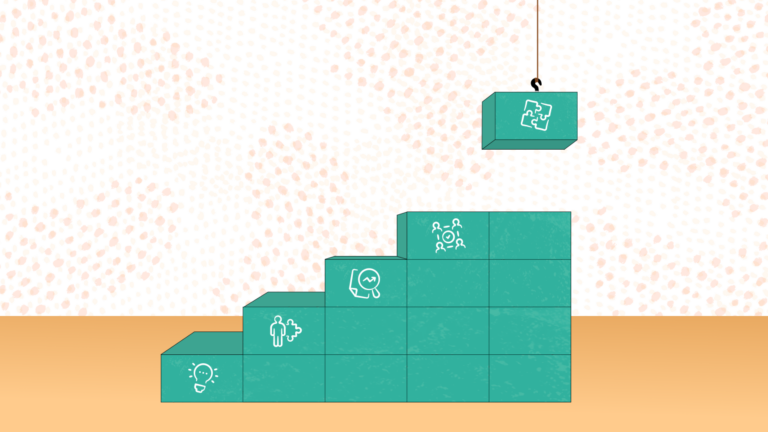Embrace a research mindset to make the most of the data your company already has

Product redesigns are inevitable. With ever-evolving technology and shifts and expansions in service offerings, companies are continually adjusting features, adding functionality, or totally overhauling their digital landscapes. Primary user research brings tailored data to these redesigns that gives the context needed and properly frames the problems at hand. However, depending on the size of the redesign, the best-practice approach to that user research might be extensive. Sometimes there isn’t the budget or the time, so you might need to get flexible.
We’ve seen what not utilizing research can do, so we’re here to help you understand how to make the most of the data you have to get answers to your questions and fully frame your problem space before diving into solutioning, redesigning, or evolving your products.
A research mindset can set you up for success
The most important best practice, that should be thought of as non-skippable, always, is to start with a research mindset. A research mindset brings you out of solution- focused thinking and allows you to question why you are making the decisions you are. It ensures you are first framing the problems in front of you before jumping to solutions. Regardless if you’ll actually do primary user research or not, it’s important to confirm you fully understand and, as a team, are aligned on the problem. As Albert Einstein said, “If I had an hour to solve a problem, I’d spend 55 minutes thinking about the problem and five minutes thinking about solutions.”
You can take a research-minded approach by first laying out what you know or what you think you know (your assumptions) about the product space in front of you. This might be in the form of a list, a mind-map style sketch that shows how things connect, or screenshots of the product with annotations or notes—whatever works for you and your team. It’s key to align on your “known knowns”. Then, identify your questions. Based on your goals and what you know today, where are your gaps or your “known unknowns”? Erika Hall has a helpful article that explains how to brainstorm questions. In it, she talks about not jumping into brainstorming solutions but instead taking a step back and identifying questions. Aligning a team around questions “[allows] your team to be thinking about the same important questions in the same words [which] will lead to better collaboration and more insights in a shorter amount of time.”
Once your team aligns on questions, you can identify how to get those answers and discuss which questions might be more important and why. There is no one “right way” to approach framing a problem; each product and user base has its own unique needs and challenges, but, ultimately, this sets you up to leverage data to answer your questions and fully frame your problem. There is never 100% certainty in product decision making, but leveraging data in the right way can increase confidence and reduce risks.
Types of data you likely already have
Let’s talk about data. Data exists in many forms: qualitative and quantitative, broad and specific, well organized and not. Primary user research data is often prioritized because it lets teams get specific about what they are learning, why they are learning it, and who they are learning from. It helps to fill in the questions and round out the problem space very directly. But, it’s not the only way to approach problem-framing. You can turn to other data sources.
By starting with the questions you have, you can identify what existing data might be able to start to answer those questions, versus spinning up primary user research efforts. Here are common data sources you might be able to learn from and how to think about each.
Past User Research Findings
What this is: This is exactly as it sounds: outputs from previously run user research efforts. They might be findings from broad generative research efforts exploring opportunity areas within a service experience overall,they might be really targeted feedback from product features, or somewhere in between.
Value this can bring: This can bring already synthesized and framed customer insights and opportunities within a given product or service experience. It can provide deeper context and perspective from the individuals who actively use the product you are redesigning.
Questions to ask yourself: There are two key questions when leveraging past research findings. First, what were the goals of the research effort and how do they relate to the goals of your redesign? Goals for a generative, exploratory effort will be different from goals for a usability test. So, you can imagine the findings will also be very different. Do the work to determine how the findings are relevant to your initiative. Second, when was the research conducted? There isn’t a definitive cutoff, but we typically encourage only looking at user research conducted within the past six months. Of course, it depends what the research is about, but it’s a good rule of thumb. Large, more exploratory efforts that aim to understand a customers’ overall experiences with a company will likely be relevant for longer than a usability test run on a product feature that has been evolving for the past quarter. You don’t want to spend time digging into data or insights that are already irrelevant because of changes with the product, experience, technology, or customer needs.
Downsides to this approach: User research is often custom-tailored to each initiative. As researchers, we spend time to understand the project goals, product goals, constraints, etc., and then identify where and what we need to learn from customers. This means that other user research that isn’t related to the current initiative will likely give good context and will help to better lay out the landscape, but it likely won’t answer the targeted questions you’ve identified.
Usage Analytics Data
What this is: Analytics data is a record of what users are interacting with within a digital product experience. It can provide details about page views, drop off points, time on pages, funnels, pathways, and so much more. There are many analytics tools out there. Google Analytics is a very well-known contender. But there are many that provide additional functionality like heatmaps, page recordings, and analysis and insights (but that’s for another blog post).
Value this can bring: Analytics data is a great starting point. We always ask clients what they can provide in terms of usage data. What do we know about what is and isn’t used within a product or website? This is a valuable starting point to user research planning because we can be sure to dig in to places that are especially interesting in the data analytics. For example, why are so many customers spending so much time on the initial setup of their accounts? Do they enjoy that? Or are they confused? And if so, what about? However, even without that deeper user context, knowing what spaces customers use most can help prioritize a redesign effort.
Questions to ask yourself: When it comes to valuable analytics data, it’s all in the setup. You might have basic page or feature use counts, but do you know how users traveled from page to page? Is tagging set up properly to allow analysis of that user data? Are analytics even enabled on the entire product? How long has the data been captured for? What kind of history of records do you have? Who owns analytic data at your company? If you have a team that owns analytics and usage, turn to them with your identified questions.
Downsides to this approach: The key thing to note is that this provides what a user is interacting with. This doesn’t help us understand why or provide any context around why one user’s pathway through a product is different than another’s.
Customer Feedback
What this is: Customer feedback is reactions and comments from your customers, typically from certain mini experiences. As a customer, you probably have gotten emails, texts, or other requests from companies asking for your thoughts on a recent experience. Searching my inbox for “feedback” brings up many requests such as “What do you think of your recent purchase?”, “Fill out a quick survey.”, “Please share your feedback – 5 minutes.”, and many more. When customers fill these out, this gives companies data to dig into. These are often a mix of quantitative rating-type or multiple-choice questions mixed with qualitative, freeform-style responses. Other types of customer feedback include Net Promoter Score (NPS) and Customer Satisfaction Score (CSAT) scores. Those are usually primarily quantitative and are more of a benchmarking tool, but they are reactionary data.
Value this can bring: This input coming directly from the customer can show common frustrations and problems, positive experiences, and even abilities that customers wish they had or could complete. NPS and CSAT scores, when properly tagged, can point to where within products or with what user groups scores are lower and can give priority and focus to the redesign work. For example, if customers are giving low NPS scores upgrading to a higher tier of services that unlocks more product features, that points to a likely problem area and might be a good place to prioritize in the redesign.
Questions to ask yourself: You’ll want to understand the quality of the data and with that, the quality of the surveys. How many customer feedback surveys exist? Who owns them? What are their purposes, and will the data even be relevant to this specific project?
Downsides to this approach: Customer feedback data is almost never centralized. It’s likely that various teams are each sending out their own surveys. Depending on the size of your company, this could mean a lot of hunting around to figure out what surveys exist, who owns them, where the data lives, how well the data is tagged, what the survey questions were, and how valuable the responses might or might not be. Another big caveat to customer feedback is that customers are much more likely to give when frustrated or unhappy. And often, this feedback is more venting and not actionable.
Customer Support Tickets (and the Customer Support Team)
What this is: If you have a customer support team or a customer issue tracking system, you’ve likely got a lot of this data. This would be the tickets or records of issues and all the calls, chats, emails, etc. It might be transcripts or recordings of conversations with customers.
Value this can bring: Similar to customer feedback, this can give insight into common problems and issues that customers are reaching out about. What this additionally brings is the context and experience of the customer care team. These individuals, especially if very tenured, likely have a solid understanding of these trends themselves. So you could dig into the tickets and trends across tickets, but also have some conversations with the care team employees themselves. Our experts can help.Do you need help with your research initiative?
Questions to ask yourself: A common consideration is the setup and organization of the data. Are the tickets tagged? In what way? Can you assess call topics overall? What common topics are high call drivers right now? What kind of quantitative trend data exists for customer support overall?
Downsides to this approach: There are a few downsides to this. One being with the tickets themselves; if these aren’t well tagged and cataloged, it’s hard to take a birds eye view. Going through individual tickets, calls, and conversations can be time consuming. Another downside is with the support team. They might bring biases based on the interactions they have with customers. They aren’t always digging into deeper needs or problems in their conversations; they are often aiming to address the issue at hand in the most efficient way possible. Lastly, relativity. Like many of the above, when data is maintained, it can be so valuable and easy to sort through. However, when it’s not, it’s like casting a wide net and then wading through information to determine what may or may not be valuable to the project you are focused on.
How to use a research mindset to leverage this data
If you’re ready to get into a research mindset, align your team around your problem space, and leverage the data you already have, follow this process:
1. Map your problem space
Even if you aren’t doing a formal primary user-research initiative, think of this step as getting into the research mindset and problem framing. Key things to include are:
- Project goals: The overall purpose of the redesign project. By the end of this project, what do you hope to complete or achieve? This could be high level or include specific metric goals. We like to organize these into overall categories and add some detail or points within each.
- Current state understanding: These are your “known knowns.” Often framed as hypotheses or assumptions to provide the space for data to change the thinking on these. This could be current problems, current successes, current unmet customer needs. It’s an organized list or diagram of the problem space today.
- Gaps & questions: These are your “known unknowns.” It’s helpful to spend time talking with teammates about your confidence in this current understanding. Talk through differences in perspectives or to look back at the project goals and identify where information might be missing in order to meet those goals. Try the “brainstorming questions” approach from Erika Hall which is shared above.
2. Prioritize your questions
For the known unknowns, start to think about the priority and importance. Flag the ones that are key to get answers to before diving into a product redesign. Which ones will make it especially hard for designers to make decisions? Identify which ones you might be able to make valid assumptions about. Think about risk if questions aren’t answered.
3. Identify how to get the answers you need
This is where you can compare your question list to the data you do have or might have. Referencing the list above, where might that usage data fill in understanding? Maybe there’s a past research effort that was related to a few of your questions. Or maybe a customer care representative could help you better understand the context around a key problem space for customers.
4. Do the work and get the answers
This might take a week or two or maybe three, but it’s going to be quicker than a full primary user research effort. While gathering information, make note of what questions aren’t answered fully and where user research might be the best path forward. Leverage the people who own the data; they might be able to help you move through it more quickly. You can also lean on AI as a tool to help you process, summarize, and identify common themes in your data.
5. Don’t be afraid to turn to your users
In the end, sometimes your existing data won’t be enough, and your users are your best bet in getting the context to properly frame your problem space or fully understanding how a product needs to function. By doing all the above first, it allows any primary user research to be very targeted. Instead of talking to users about the entire product experience, maybe you focus solely on the product setup experience. And maybe even with a very specific type of user. This can set up any user research to be very purposeful and thoughtful. This can also happen in tandem with other efforts—user research doesn’t need to be a waterfall process. Redesigns can start for certain parts of a product while unanswered questions are explored for other features or functionality.
6. Be sure to update and share your new understanding
Don’t forget to come back together as a team. Go back to that current understanding and make updates. Allow data and answers gathered to fill in new parts of how you view the problem space as a team. A deeper understanding will help to prioritize what might need to be tackled first as well as provide context for each feature or workflow.
Leverage the data you do have, shift into a research mindset
Product redesigns are happening all the time. Each redesign brings new decisions for the future of a product or experience. When primary user research isn’t feasible, turning to data you already have can get your team into a research mindset and bring context needed. This sets yourself and your team up to be better aligned around the problems you’re solving together. Ultimately, a research mindset approach will give you more confidence in your decision making and help to prioritize your redesign efforts.
Are you starting a redesign project? We can help you utilize the data you have to ensure you’re making the right design decisions. Let’s chat.



